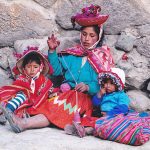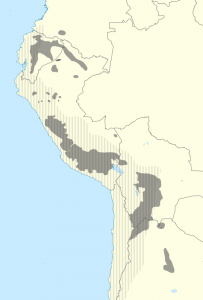25 The Inca/Quechua

The Incan empire pulled together various smaller tribes over time and truly flourished between about 1400 and 1500 CE, largely in an area which is now Peru. The Incan empire and culture was thoroughly and horribly destroyed by the Spanish under the leadership of Francisco Pizarro. In a very short period of time, the Spanish stole over 280,000 kilograms of gold from the Incas and as they conquered the people and stole this wealth, they also suppressed or destroyed all expression of their native religion and culture. Yet in spite of the harsh treatment by the various explorers and conquerors, some Incan traditions managed to survive and carry forward in the myths, beliefs and practices within Peru, Ecuador and Columbia. The heirs to the Incas are now called various names and form many tribes, but speak the language called Quechuan. Calling this group of tribes Quechua is a catch all phrase in some ways, but refers to many varied but related clan groups in the Andes mountain region.
History and Belief
Gordon McEwan is an associate professor of anthropology at Wagner College. He has worked in Cuzco for more than twenty-five years and is the author of numerous articles and several books on the archaeology of the Wari and Inca cultures. Here is his introduction to the Incan society. [You will complete this as part of a PlayPosit assignment.] The remaining people who fled at the destruction of the Incan empire are the people whose descendants remain in the mountains of the western shore of South American today.
Although many of the Quechua speaking people have incorporated Roman Catholicism into their lives, some beliefs common to the Incas that still survive today in the lives of the Quechuas include:
- a belief that supernatural forces govern everyday events, such as weather, crops, health and illness
- making offerings to the powers that control natural forces, the Quechua feel they can influence events and not merely be helpless in the face of bad weather or disease
- the conviction that the world is populated by spirits who have human attributes
- the conviction that the mountains are sacred places and are central elements of a mythical historical identity, since the founding fathers, according to Inca legend, arose directly out of the land
- belief in the Andean deities Viracocha (creator deity) and Pachamama (the Incan Mother Earth)
Location

with the historical extent of the Inca Empire (shaded)
The Incas originally held a great deal of territory along the western coast of what is now South America. Although much of this is rugged, we can notice that a familiar place belonging to the Incas is Machu Picchu.
UNESCO shows pictures of this area, a 15th-century Inca citadel, located in the Eastern Cordillera of southern Peru, on a 7,970 foot mountain ridge. “Recent research has shown that the site’s location, and the orientation of its most important structures, was strongly influenced by the location of nearby holy mountains, or apus. (The Inca religion uses the term ‘apu’ to refer to a mountain with a living spirit; the body and energy of the mountain together form the spirit’s wasi (“home” or “temple”).) An arrow-shaped stone atop the peak of Huayna Picchu appears to point due south, directly through the famous Intihuatana Stone, to Mount Salcantay, one of the most revered apus in Incan cosmology. On important days of the Inca calendar, the sun can be seen to rise or set behind other significant peaks.”[3]
Lifestyle
The present-day Quechua-speaking peoples of the Andes make up between 30- 45 percent of the population of Peru, Colombia, Bolivia and Ecuador. They live in close-knit, generally rural, communities and combine farming and herding to make a living. Much of the agricultural work is done cooperatively, sharing grazing space, harvests and redistributing labor and the outcome of farming when needed.
All aspects of Quechua life, including farming, marriage relationships, religion and celebrations, are done in an ayllu, which is an involved and clan-like kinship grouping. A basic component of ayllu communality is ayni, which in a fairly simple way can be described as “help rendered to others today in anticipation of that help being returned at a future date”. Ayni is reciprocal assistance, so that members of an ayllu will help a family with a large project, such as putting up fencing or construction of a home, and in turn can expect to be similarly helped later with a project of their own.
Many traditional handicrafts are an important part of Quechua culture. This includes

a long tradition of weaving handed down from Incan times (or possibly even earlier than the 14th century) using cotton, wool (from llamas, alpacas, guanacos, vicunas) and a wide variety of natural dyes. There are numerous traditional woven patterns used (pallay).
The Quechua domesticated potatoes thousands of years ago and still grow many potato varieties, which are used for both food and medicine. Quinoa is another traditional crop used as a staple, and is fast becoming so expensive that unless individuals grow their own crop of quinoa, they are no longer able to afford to buy it, as the grain has become very popular in the Western cultures.
Hallpay is the Andean ritual of chewing coca leaves, which produces a mild stimulation. Growing coca for cocaine production is illegal in these countries, but personal use in the Quechua communities, who just chew the coca leaves, is accepted. An explanation is found here:
[The] varied procedures and social etiquette have been compared in intricacy to the Japanese tea ceremony. Each person selects a few of the best leaves and stacks them shiny side up (the stack is called a k’intu). The individual then blows on the stack lightly while reciting a short blessing to the earth and particular location (known as a phukuy). If another person is present (as is often the case), the k’intu is then passed to that person, who receives it with thanks before reciting a phukuy again. Only then are the coca leaves inserted in the mouth for chewing.[4]
Ritual
Many rituals in Quechuan speaking communities are now a combination of Roman Catholic and native practices. Some hark back to Incan times, some are more recent in origins, but still blend with Catholicism.
- The Festival of the Sun (Inti Raymi) is based on an ancient Incan ceremony and includes elaborate pageantry and the (simulated) sacrifice of a llama.
- the Andean deities Viracocha (creator deity) and Pachamama (the Incan Mother Earth) have become associated with the Christian faith, and connect to God and to the Virgin Mary, respectively, as a syncretic approach to religion.
- Religious imagery—frequently associated with miracles, visions, and punishments—often plays an important role in the spiritual beliefs. The line between the Christian images and the Quechua images blurs.
- Ritual offerings to Pachamama (in a ceremony known as the pago a la tierra) continue to be performed regularly. The pago a la tierra ceremony traces its roots back to traditional Inca festivals of harvests and plantings.
- pilgrimages to sacred spaces, again often a combination of Catholic imagery imposed on ancient sites in the mountains, are common. They tend to be more festive in actions than somber or serious.
- The characteristic music of the central Andes is called huayno. The Incas used a single word– “taqui”– to describe dance, music and singing, though this word in the Quechuan language means “song”. Theses three activities were interconnected, never separated. Most dances were related to rituals and agriculture. And all music was communally produced, as music was considered a group activity. Music uses a variety of traditional instruments, varying from percussive items to strings to flute like we hear in this example:
Traditional Music from the Andes
“Cultural Orientation – Quechua.” Defense Language Institute Foreign Language Center, 2021, www.dliflc.edu/cultural-orientation-quechua/.
“Field Support, Cultural Orientation.” Quechua Cultural Orientation, 2021, fieldsupport.dliflc.edu/products/quechua/qu_co/default.html.
Centre, UNESCO World Heritage. “Historic Sanctuary of Machu Picchu.” UNESCO World Heritage Centre, 2021, whc.unesco.org/en/list/274.
The Religion of the Quechua, Division of Religion and Philosophy University of Cumbria, 2021, www.philtar.ac.uk/encyclopedia/latam/quech.html.
“Quechua.” Junior Worldmark Encyclopedia of World Cultures, edited by Timothy L. Gall and Susan Bevan Gall, 2nd ed., vol. 7, UXL, 2012, pp. 161-168. Gale In Context: High School, link.gale.com/apps/doc/CX1931400389/GPS?u=mnalakescl&sid=bookmark-GPS&xid=7dc890c3. Accessed 26 Aug. 2021.
Gibson, Karen. “The Quichua.” Faces: People, Places, and Cultures, vol. 22, no. 4, Dec. 2005, pp. 36+. Gale In Context: High School, link.gale.com/apps/doc/A142567681/GPS?u=mnalakescl&sid=bookmark-GPS&xid=fce12bf1. Accessed 26 Aug. 2021.
Waddington, R. (2003), The Indigenous Quichua People. The Peoples of the World Foundation. Retrieved August 26, 2021, from The Peoples of the World Foundation.
<http://www.peoplesoftheworld.org/text?people=Quichua>
“Cultures of The Andes: Quechua Songs & Poems, Stories, Photos…” Cultures of the Andes: Quechua Songs & Poems, Stories, Photos…, 2021, www.andes.org/.
“Inca Creation Myth.” The Big Myth, 22 June 2020, youtu.be/rr8pFiL1FWI.

